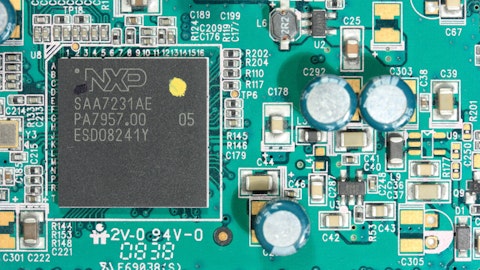Harsh Kumar: Hey, guys. I had a couple of questions as well. I guess I was more curious about the spurt in the ATS business. Was there anything that happened in the end market or maybe your own focus as a company prompted this kind of growth? And then my second one is kind of tied to it, so I’ll just ask it anyways. Historically, the model has been that ATS drives wafer revenues. But wafer revenues are coming down. Is that mostly the industrial sort of, call it, flushing out this year? Or is there something else going on, maybe a shift in strategy perhaps?
Thomas Sonderman: Yes. Well, so to answer the first question, it’s all about transformation. We clearly are doing everything we can to maximize our ability to move our ATS programs as quickly as possible through the development cycle while at the same time delivering consistent Wafer Services output. That’s what we’ve really been doing. I think our ability to not only execute the transition while delivering solid financial performance is a good testament to the team. And the kind of positioning legacy products and phasing those out as we move towards these new programs, it’s kind of always been the plan for SkyWater when we spun out of Cypress. We have never put a lot of energy into our legacy mature technologies. They are there to fill the fab to allow the new business to be developed and put in a position to grow in the long term, and that’s exactly what we’ve been doing.
And really, as we said, ’23 was driving that transformation. We’ve executed it, and now we’re leaning into it hard and really taking advantage of maybe, call it, a weaker broad market to move some of these ATS programs at a faster pace and specifically the DoD programs, which, as we’ve been talking all year, already moving at a very fast pace. Anything to add, Steve?
Steve Manko: Good response. Harsh?
Harsh Kumar: Sorry, my second one was regarding the Wafer Services flushing out, I guess. And that just basically strictly sounds like it’s industrial, correct?
Thomas Sonderman: Yeah. I mean the — a lot of the industrial products are legacy products. I think there was a lot of inventory building in the industrial space. And as our primary customer, Infineon has made very public, there they’re digesting that inventory. And obviously, for those type of products, we feel the effect of that as well. And that’s really what we see happening as this year unfolds. And in parallel, we’re going to continue to drive these ATS transitions and get these new tools installed, which ultimately just drive faster ATS transitions as well.
Harsh Kumar: Gotit. Fair enough guys. Thank you.
Operator: And we’ll move next to Robert Mertens at TD Cowen.
Robert Mertens: Hi. This is Rob Mertens on for Krish. The first one, you’d mentioned that the aero and defense customers were a big part of calendar year ’23 revenues. What would you expect the mix to sort of look like throughout this year? And will this materially shift in calendar year ’25 as Wafer Services start to recover? And then I have one follow-up.
Thomas Sonderman: Yeah. I mean I think as I put in my remarks, A&D is going to continue to grow. It was over 50% in ’23. We expect that to increase further in ’24. Again, there’s a lot of focus on moving those programs very quickly. So we’re taking advantage of that. And given the weakness and the broader Wafer Services market, as we just discussed, and the pace of transition for some of our commercial programs, we expect A&D to continue to be a strong contributor through this year and into next year as well.
Robert Mertens: Great. That’s helpful. And then just a quick follow-up. I want to make sure I heard correctly that — the consulting fees, were they $3.5 million in the December quarter? And then just based on the March guide of $14 million to $15 million OpEx, what are you sort of thinking the consulting fees would look like there then in out quarters?
Steve Manko: Yeah. The transformation cost is what we referred to, and you can see those broken out in the non-GAAP tables in the supplements to the earnings release, were $5.3 million for the quarter, and again, went to around $11.3 million for the year. And as Tom mentioned, there is not an expectation of those recurring again in the year 2024.
Robert Mertens: Okay. Got it. That’s helpful.
Operator: Next, we’ll go to Richard Shannon at Craig-Hallum.
Richard Shannon: Hi. Thanks for taking my questions as well. Maybe the first question is for Steve. I tried to absorb all the numbers here in terms of the guide for the year, and I just wanted to try to ask it. The question I have here is really thinking about the exit rate of gross margins exiting this year, both with and without tool sales. I tried to run all your numbers through here, and I wonder if you could just give us your thoughts here. You started with a 19.5% or 19% change or 19% number here in the first quarter. Obviously, you got a lot of depreciation kicking off after that. I mean is this something where we get into the upper half of the 20s exiting this year or how should we think about that?




